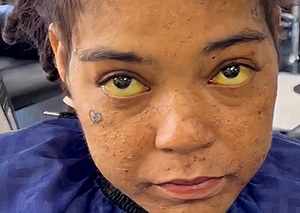
There is sad news to report today. Secretary of State Hillary Rodham Clinton was hospitalized over the weekend with a blood clot.
A blood clot is a lump of red blood cells gelled together.
Mrs. Clinton fell at home and suffered a concussion earlier this month. She has not been seen publicly in 3 weeks. Doctors discovered the blood clot when they ran follow-up tests this weekend.
Clinton was immediately hospitalized and administered blood thinners to dissolve the clot (thrombolytics) and/or to prevent other clots from forming (anticoagulants).
Mrs. Clinton may have had a blood clot in her lung that traveled up her leg after being bedridden for 3 weeks. But the clot could have formed in her brain after she fell.
The seriousness of a blood clot “depends on where it is,” said Dr. Gholam Motamedi, a neurologist at Georgetown University Medical Center who was not involved in Clinton’s care.
Dr. Larry Goldstein, a neurologist who is director of Duke University’s stroke center told the Associated Press that blood clots in the legs and lungs can be dissolved with potent blood thinners. But clots in the brain cannot.
Strokes occur when blood vessels in the brain are damaged, cutting off blood supply to a particular part of the brain.
A blood clot traveling from the leg to the lungs or brain is called an embolus. Blood clots in the lungs are called pulmonary emboli or pulmonary embolus. A blood clot in the brain can cause ischemia (cell death due to lack of oxygen) causing that part of the brain to die.
SIGNS SYMPTOMS
Blood clots in the brain can cause mild to severe problems with mobility, speech, and visual acuity. 85% of strokes are caused by blood clots.
Signs and symptoms of blood clots or a stroke include:
A blood clot is a life threatening emergency. If you have any of these signs or symptoms you should contact your doctor or get to an emergency room.
DIAGNOSIS
Tests to rule out blood clots depends on the location of the clots. The tests include CT Scans, MRI (brain), ECG (heart), Chest X-rays or pulmonary angiogram (lungs), Ultrasound (legs, arms or elsewhere in the body), blood tests (legs, arms or elsewhere in the body).
TREATMENT
Treatment of blood clots include blood thinners, procedures or surgery to remove a large clot, placement of a vein filter to trap small clots in the legs and prevent them from reaching the brain, lungs or heart. Rehab or light exercise (to prevent clots from reoccurring), taking medication for high blood pressure, and drinking plenty of water to prevent dehydration.
According to an aide, Mrs. Clinton is expected to be released from the hospital in 24-48 hours. She will probably be sent home with a prescription for blood thinners such as Aspirin (to prevent her blood from clotting), or compression stockings (to help with blood circulation in her legs.)
This has been your Medical Minute.
More Info on the Web
Pulmonary Embolism – Mayo Clinic
Pulmonary Embolism – WebMD
Pulmonary Embolism – MedlinePlus
Brain Ischemia (Stroke) – Tnhealth
DISCLAIMER
Any medical information published on this blog is for your general information only and is not intended as a substitute for informed medical advice. You should not take any action before consulting with your personal physician or a health care provider. Sandrarose.com and its affiliates cannot be held liable for any damages incurred by following advice found on this blog.





